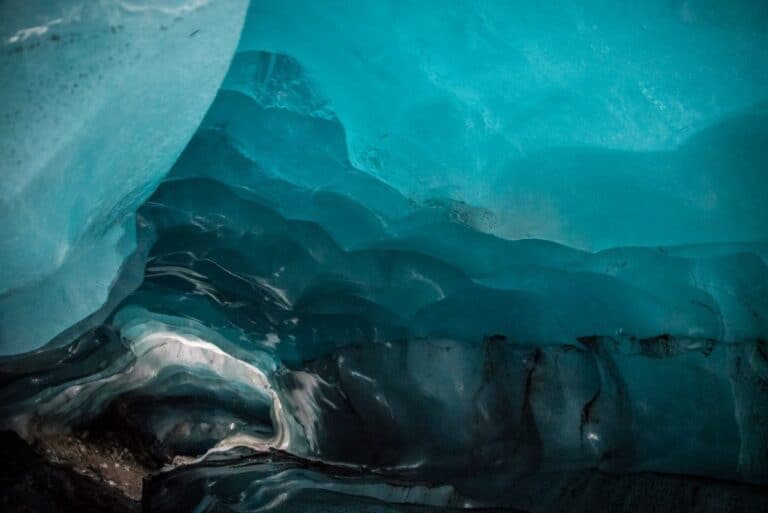Caves, also known as caverns, are naturally-created voids in the ground that can usually accommodate people who want to enter and explore. They’re formed by rock weathering and extend deep in the earth. In some cases, the word “cave” is used to describe smaller openings, similar to sea caves. The science behind exploring caves is called speleology, and many people enjoy this activity because of the incredible natural mysteries that caves hold.
What are Iceland Ice Caves?
Iceland ice caves take the experience to a whole new level. Ice caves in Iceland form when water melts through a glacier, creating caverns and pathways. This phenomenon occurs during the summer months when the sunlight melts the water on a glacier’s surface.
If you dream of visiting natural Iceland ice caves, here’s what you need to know about the best ice caves in Iceland. There are spectacular ice cave tours in Iceland that can take you to the most magnificent caves and ice tunnels. Iceland is the home of the Vatnajokull ice caves, amongst others.
Are you ready for an adventure? Let’s explore ice caves near Reykjavik!
History of Iceland Ice Caves
Over 11% of Iceland’s landscape is covered by glaciers. Many of these glaciers are so massive that they overtake the mountains and valleys. A prime example is the Vatnajokull glacier cave, covering Iceland’s highest peak, Hvannadalshnjúkur.
Frozen water has been part of Iceland’s landscape since long before the first settlements. A Norweigen man named Naddoddur was first to explore Iceland’s sand shore and declared the Icelandic landscape as uninhabitable. Hrafna-Flóki was the first person to name the country Iceland.
Ice and cold weather have been the constant climate in Iceland for centuries, sculpting the landscape into a beautifully diverse environment. Iceland has become a prime holiday destination with dramatic mountain slopes, glaciers, wildlife, and breathtaking cave systems.
Ice Caves vs Glacier Ice Caves
Despite what most people think, Iceland ice caves and glacier ice caves are different. An ice cave is a natural cave that has some ice in it throughout the year. On the other hand, a cave that’s made entirely of ice is a glacier cave. Iceland is home to both. Glacier caves are a stunning, icy blue in their entirety. Ice caves sometimes showcase this majestic blue, but it’s mixed with other colors, such as black and copper.
If you’re particular about which type of cave you want to visit, make sure you read the tour description and check out any available pictures, so you know exactly what you’ll experience. Generally, ice cave guided tours actually feature glacier caves such as Vatnajokull glacier cave.
Popular Ice Caves in Iceland
For all the shutterbugs out there, nothing beats a photo taken inside a blue ice cave. Iceland boasts several ice caves and glacier caves to explore. Not all are accessible, but there are still plenty of great options to choose from. Accessibility generally comes down to environmental factors, such as earthquake activity, flooding, etc. Tour guides know where to go to keep you safe.
Vatnajokull Ice Caves
Located in the south region, the Vatnajokull ice caves are some of the most stunning and best-known ice caves in Iceland. A photographer’s dream setting, Vatnajokull features spectacular, turquoise-blue ice tunnels. Iceland will wake up your spirit. No picture can completely capture the beauty you’ll witness in person.
Katla Ice Caves
These beautiful caves are open to visitors all year long, making them a safe bet for a fantastic adventure! Katla caves are also located in south Iceland. Katla is an active volcano covered by a glacier, close to the Vik i Myrdal village on the coast. In the caves, guests will witness black volcanic ash layers, safely hidden underneath the ice. The ashy look of the Katla caves gives it a unique, dazzling color, adding to the visual awe.
Langjökull Ice Tunnel
Rated the second-largest glacier in Iceland, Langjokull is the closest experience if you’re staying in Reykjavik. This is a man-made tunnel, created to accommodate visitors who might be willing to visit other ice caves. But that doesn’t take away from the incredible experience you’ll have if you choose to go on a tour at the Langjokull ice tunnel. You’ll get to ride a 4×4 snowcat down dramatic glacier slopes. If a 4×4 scares you, you can opt for the snowmobile tour instead. Inside these vast tunnels, you can see an ice chapel decorated by lights, creating dazzling reflections.
Lofthellir Ice Cave
Lofthellir is among the most beautiful ice caves you can witness, filled with stalagmites that drop from the ceiling and grow up from the floor. Lofthellir falls in the category of Iceland ice caves, rather than glacier caves. For this reason, you can expect to walk through dark tunnels, so it’s not for the faint at heart. Lofthellir is home to a superb collection of ice sculptures, and the experience may require some climbing to get the full effect.
When is the Best Time to Visit Iceland Ice Caves?
The best time to venture into the Iceland ice caves is generally from the middle of November through the middle of March. The rest of the year is usually warmer, causing the glaciers to melt and send cold water through the caves and the tunnels. Other dangers that come along with warmer temperatures include the possibility of certain parts of the caves cracking and collapsing. Therefore, it’s safer to visit the caves when the weather is colder.
Experience Stunning Iceland Ice Caves
Exploring Iceland comes with a sense of unparalleled freedom for the traveler’s spirit. Iceland’s dramatic landscapes are nothing short of breathtaking. Rent.is offers comfortable, top-of-the-line Iceland van rentals to help you discover Iceland on your way to visit ice and glacier caves. Contact us for more information.


